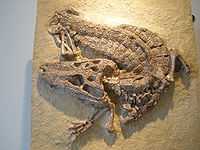
This is a photograph of the skeleton of Alligator prenasalis. Credit:
Ghedoghedo.
Biology is a lecture and an article as part of the biology series.
You are free to take this quiz based on biology at any time.
To improve your score, read and study the lecture, the links contained within, and listed under See also. This should give you adequate background to get 100 %.
As a "learning by doing" resource, this quiz helps you to assess your knowledge and understanding of the information, and it is a quiz you may take over and over as a learning resource to improve your knowledge, understanding, test-taking skills, and your score.
A suggestion is to have the lecture available in a separate window.
To master the information and use only your memory while taking the quiz, try rewriting the information from more familiar points of view, or be creative with association.
Enjoy learning by doing!
Quiz
Hypothesis:
- Something may be a fossil if it is discovered in sediment.

This is an image of a Lewis rat. Credit: Charles River Laboratories.
The findings demonstrate a statistically systematic change from the status quo or the control group.
“In the design of experiments, treatments [or special properties or characteristics] are applied to [or observed in] experimental units in the treatment group(s).[1] In comparative experiments, members of the complementary group, the control group, receive either no treatment or a standard treatment.[2]"[3]
Def. a “short and/or incomplete realization of a certain method or idea to demonstrate its feasibility"[4] is called a proof of concept.
Def. evidence that demonstrates that a concept is possible is called proof of concept.
The proof-of-concept structure consists of
- background,
- procedures,
- findings, and
- interpretation.[5]
See also
References
- ↑ Klaus Hinkelmann, Oscar Kempthorne (2008). Design and Analysis of Experiments, Volume I: Introduction to Experimental Design (2nd ed.). Wiley. ISBN 978-0-471-72756-9. http://books.google.com/?id=T3wWj2kVYZgC&printsec=frontcover.
- ↑ R. A. Bailey (2008). Design of comparative experiments. Cambridge University Press. ISBN 978-0-521-68357-9. http://www.cambridge.org/uk/catalogue/catalogue.asp?isbn=9780521683579.
- ↑ "Treatment and control groups, In: Wikipedia". San Francisco, California: Wikimedia Foundation, Inc. May 18, 2012. Retrieved 2012-05-31.
- ↑ "proof of concept, In: Wiktionary". San Francisco, California: Wikimedia Foundation, Inc. November 10, 2012. Retrieved 2013-01-13.
- ↑ Ginger Lehrman and Ian B Hogue, Sarah Palmer, Cheryl Jennings, Celsa A Spina, Ann Wiegand, Alan L Landay, Robert W Coombs, Douglas D Richman, John W Mellors, John M Coffin, Ronald J Bosch, David M Margolis (August 13, 2005). "Depletion of latent HIV-1 infection in vivo: a proof-of-concept study". Lancet 366 (9485): 549-55. doi:10.1016/S0140-6736(05)67098-5. http://www.ncbi.nlm.nih.gov/pmc/articles/PMC1894952/. Retrieved 2012-05-09.
External links
| Anthropology resources |
|---|
| | Activities | | | | Articles | | | | Categories |
Agriculture ·
Anthropology ·
Archaeology ·
Art ·
Arts ·
Biological Anthropology ·
Culture ·
Dominant group ·
Education ·
Evolutionary anthropology ·
Evolutionary psychology ·
Genetics ·
History ·
Humanities ·
Language ·
Linguistics ·
Literature ·
Medicine ·
Mythology ·
Philosophy ·
Psychology ·
Religious studies ·
Semantics ·
Social anthropology ·
Social psychology
| | | Courses | | | | Fields | | | | Glossaries | | | | Lectures | | | | Lessons | | | | Lists |
| | | Original research | | | | Portals |
History ·
Social sciences
| | | Problem sets | | | | Projects | | | | Proposals | | | | Quizzes | | | | Schools |
Agriculture ·
Alternative medicine ·
Anthropology ·
Archeology ·
Classics ·
Dentistry ·
Gastronomy ·
History ·
Life ·
Medicine ·
Pharmacy ·
Veterinary medicine
| | | Topics | |
|
| Gene project |
|---|
| | Activities |
| | | Articles | | | | Categories |
Agriculture ·
Biochemistry ·
Biology ·
Genetics ·
Medicine ·
Molecular evolution ·
Research projects ·
Zoology
| | | Courses | | | | Lectures | | | | Lessons | | | | Lists | | | | Original research | | | | Projects | | | | Proposals | | | | Quizzes | | | | Schools |
Agriculture ·
Alternative medicine ·
Biology ·
Brewing ·
Chemistry ·
Conservation Sciences ·
Dentistry ·
Gastronomy ·
Life ·
Marine sciences ·
Medicine ·
Pharmacy ·
Plant sciences ·
Veterinary medicine ·
Zoology
| | | Topics | |
|
| Medicine resources |
|---|
| | Activities | | | | Articles | | | | Categories |
Anatomy ·
Anesthesiology ·
Basic sciences ·
Blood tests ·
Cardiovascular medicine ·
Clinical Skills ·
Clinical trials ·
Complementary and alternative medicine ·
Dentistry ·
Dermatology ·
Diseases ·
Emergency Medicine ·
Endocrinology ·
Evidence-based Medicine ·
Gastroenterology ·
Geriatric medicine ·
Gerontology ·
Health ·
Healthcare ·
Hematology ·
Medical biophysics ·
Medical emergencies ·
Medical physics ·
Medical subject headings ·
Medicinal plants ·
Medicinal plants and wild foods ·
Medicine ·
Medicine stubs ·
Military Medicine ·
Nephrology ·
Neuroprotection ·
Oncology ·
Ophthalmology ·
Orthopedics and Rheumatology ·
Otolaryngology ·
Otorhinolaryngology ·
Pain ·
Pathology ·
Pharmacy ·
Physiology ·
Podiatry ·
Primary Care Medicine ·
Proctology ·
Psychiatry ·
Regenerative medicine ·
Reproductive medicine ·
Respiratory medicine ·
Risk management ·
School of Medicine Brainstorming ·
Urology
| | | Courses | | | | Glossaries | | | | Lectures | | | | Lessons | | | | Lists | | | | Problem sets | | | | Projects |
Gene Project ·
Medicine/Projects
| | | Quizzes | | | | Schools |
Medicine/Schools ·
Alternative medicine ·
Biology ·
Dentistry ·
Gastronomy ·
Medicine ·
Nursing ·
Pharmacy ·
School Health ·
Veterinary medicine ·
Zoology
| | | Syndromes | | | | Topics |
Medicine/Topics ·
Anesthesiology ·
Angiology ·
Anatomy ·
Basic sciences ·
Biology ·
Biomedical gerontology ·
Biomedicine ·
Cardiovascular medicine ·
Chemistry ·
Clinical skills ·
Community medicine ·
Cytogenetics ·
Emergency Medicine ·
Endocrinology ·
Epidemiology ·
Evidence-based Medicine ·
Gastroenterology ·
General surgery ·
Genetics ·
Geriatric Medicine ·
Health Informatics ·
Hematology ·
Histology ·
Immunology ·
Internal medicine ·
Laboratory Techniques ·
Medical physics ·
Medicinal botany ·
Medicinal chemistry ·
Military medicine ·
Nephrology ·
Neurology ·
Oncology ·
Ophthalmology ·
Orthopedics and Rheumatology ·
Otorhinolaryngology ·
Pathology ·
Pediatric Medicine ·
Pharmacology ·
Physiology ·
Primary Care Medicine ·
Psychiatry ·
Psychology ·
Regional Anatomy ·
Reproductive Medicine ·
Respiratory Medicine ·
Rheumatology ·
Serology ·
Virology ·
|
|
| Phosphate biochemistry |
|---|
| | Activities |
| | | Articles | | | | Courses | | | | History |
| | | Lectures |
Adenosine triphosphate ·
Bones ·
Cartilage ·
Cytoskeleton ·
Degenerate nucleotide ·
Deoxyribonucleic acid ·
Epigenome ·
Extracellular fluid ·
Ferredoxin ·
Flavodoxin ·
Human bones ·
Human teeth ·
Hydroxyapatite ·
Inorganic pyrophosphatase ·
Microfilaments ·
Microtubules ·
Nucleic acids ·
Nucleoside triphosphate ·
Organophosphate ·
Origin of life: polyphosphate ·
Oxidative phosphorylation ·
Phosphatases ·
Phosphate minerals ·
Phosphates ·
Phosphate biochemistry ·
Phosphate budget ·
Phosphate homeostasis ·
Phosphate reactions ·
Phosphate transistasis ·
Phospholipids ·
Phosphoramidates ·
Phosphoric acid ·
Phosphorites ·
Phosphorylation ·
Polyphosphates ·
Skeletons ·
Structural phosphates ·
Superphosphate ·
Teeth
| | | Lessons |
| | | Original research |
Biosynthesis of a human protein
| | | Proposal |
| | | Quizzes | | | | Schools |
Business ·
Chemistry ·
Conservation sciences ·
Geology ·
Physics and Astronomy
| | | Topics |
Earth science ·
Geochemistry ·
Historical geology ·
Mineralogy ·
Mining geology ·
Molecular biology ·
Oceanography ·
Paleontology ·
Proteomics ·
Soil science ·
Stratigraphy
|
|
 This is a research project at http://en.wikiversity.org
This is a research project at http://en.wikiversity.org
 |
Development status: this resource is experimental in nature. |
 |
Educational level: this is a research resource. |
 |
Resource type: this resource is a quiz. |
 |
Subject classification: this is a biology resource . |

![]() This is a research project at http://en.wikiversity.org
This is a research project at http://en.wikiversity.org